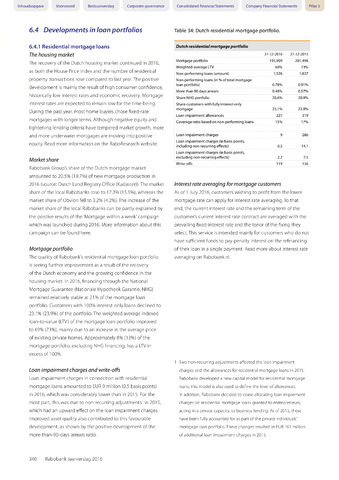6.4 Developments in loan portfolios
Inhoudsopgave Voorwoord Bestuursverslag Corporate governance Consolidated Financial Statements Company Financial Statements Pillar 3
Table 34: Dutch residential mortgage portfolio.
6.4.1 Residential mortgage loans
The housing market
The recovery of the Dutch housing market continued in 2016,
as both the House Price Index and the number of residential
property transactions rose compared to last year. The positive
development is mainly the result of high consumer confidence,
historically low interest rates and economic recovery. Mortgage
interest rates are expected to remain low for the time being.
During the past year, most home buyers chose fixed-rate
mortgages with longer terms. Although negative equity and
tightening lending criteria have tempered market growth, more
and more underwater mortgages are moving into positive
equity. Read more information on the RaboResearch website.
Market share
Rabobank Group's share of the Dutch mortgage market
amounted to 20.5% (19.7%) of new mortgage production in
2016 (source: Dutch Land Registry Office (Kadaster)).The market
share of the local Rabobanks rose to 17.3% (15.5%), whereas the
market share of Obvion fell to 3.2% (4.2%).The increase of the
market share of the local Rabobanks can be partly explained by
the positive results of the 'Mortgage within a week' campaign
which was launched during 2016. More information about this
campaign can be found here.
Mortgage portfolio
The quality of Rabobank's residential mortgage loan portfolio
is seeing further improvement as a result of the recovery
of the Dutch economy and the growing confidence in the
housing market. In 2016, financing through the National
Mortgage Guarantee (Nationale Hypotheek Garantie, NHG)
remained relatively stable at 21% of the mortgage loan
portfolio. Customers with 100% interest-only loans declined to
23.1% (23.9%) of the portfolio. The weighted average indexed
loan-to-value (LTV) of the mortgage loan portfolio improved
to 69% (73%), mainly due to an increase in the average price
of existing private homes. Approximately 8% (13%) ofthe
mortgage portfolio, excluding NHG financing, has a LTV in
excess of 100%.
Loan impairment charges and write-offs
Loan impairment charges in connection with residential
mortgage loans amounted to EUR 9 million (0.5 basis points)
in 2016, which was considerably lower than in 2015. For the
most part, this was due to non-recurring adjustments1 in 2015,
which had an upward effect on the loan impairment charges.
Improved asset quality also contributed to this favourable
development, as shown by the positive development ofthe
more-than-90-days arrears ratio.
Dutch residential mortgage portfolio
31-12-2016
31-12-2015
Mortgage portfolio
195,909
201,498
Weighted-average LTV
69%
73%
Non-performing loans (amount)
1,526
1,837
Non-performing loans (in of total mortgage
loan portfolio)
0.78%
0.91%
More than 90 days arrears
0.48%
0.57%
Share NHG portfolio
20.6%
20.9%
Share customers with fully interest-only
mortgage
23.1%
23.9%
Loan impairment allowances
227
319
Coverage ratio based on non-performing loans 15% 17%
Loan impairment charges
9
286
Loan impairment charges (in basis points,
including non-recurring effects)
0.5
14.1
Loan impairment charges (in basis points,
excluding non-recurring effects)
2.7
7.5
Write-offs
119
156
Interest rate averaging for mortgage customers
As of 1 July 2016, customers wishing to profit from the lower
mortgage rate can apply for interest rate averaging. To that
end, the current interest rate and the remaining term ofthe
customer's current interest rate contract are averaged with the
prevailing fixed-interest rate and the tenor ofthe fixing they
select.This service is intended mainly for customers who do not
have sufficient funds to pay penalty interest on the refinancing
of their loan in a single payment. Read more about interest rate
averaging on Rabobank.nl.
1 Two non-recurring adjustments affected the loan impairment
charges and the allowances for residential mortgage loans in 2015.
Rabobank developed a new capital model for residential mortgage
loans; this model is also used to define the level of allowances.
In addition, Rabobank decided to cease allocating loan impairment
charges on residential mortgage loans granted to entrepreneurs,
acting in a private capacity, to business lending. As of 2015, these
have been fully accounted for as part ofthe private individuals'
mortgage loan portfolio.These changes resulted in EUR 161 million
of additional loan impairment charges in 2015.
340 Rabobank Jaarverslag 2016

